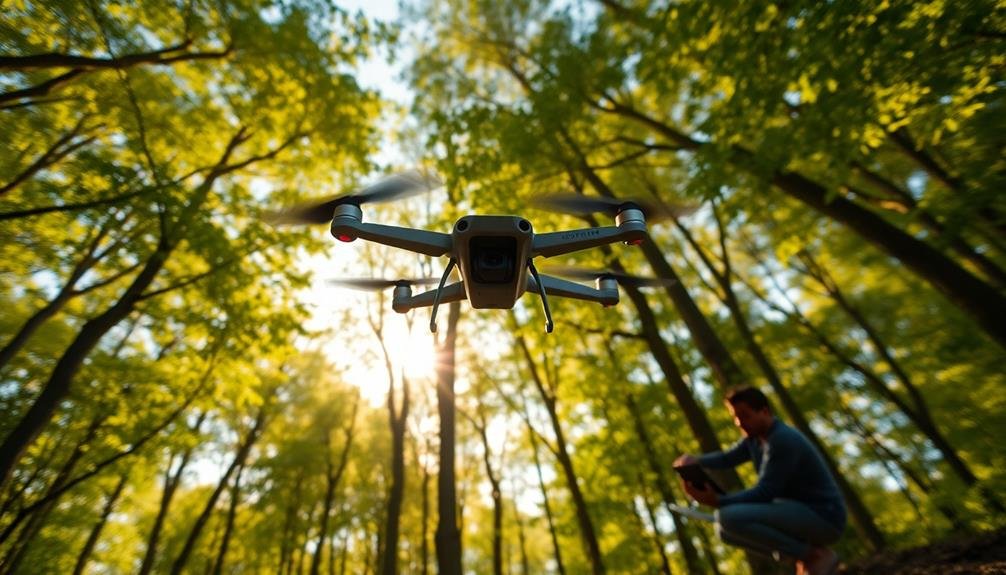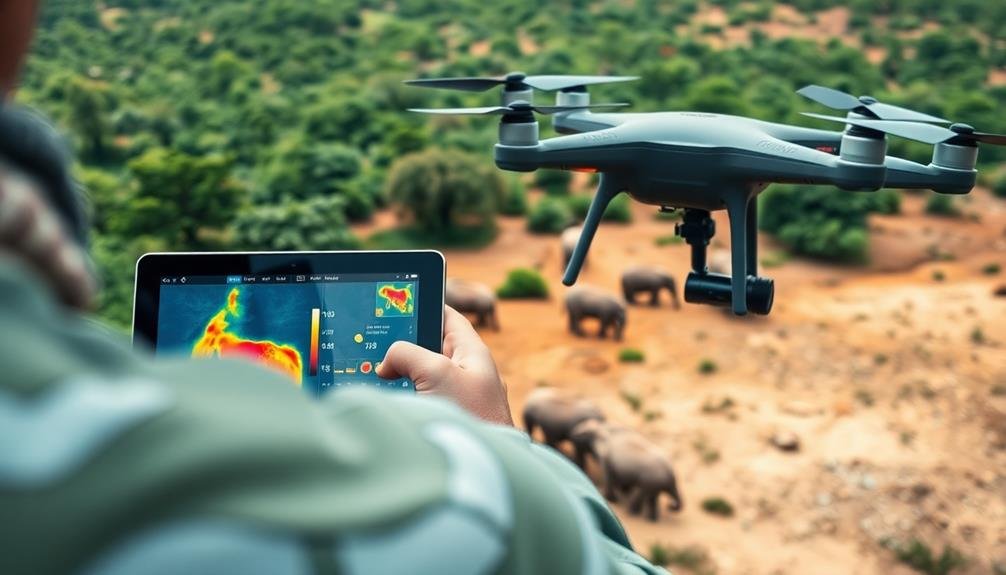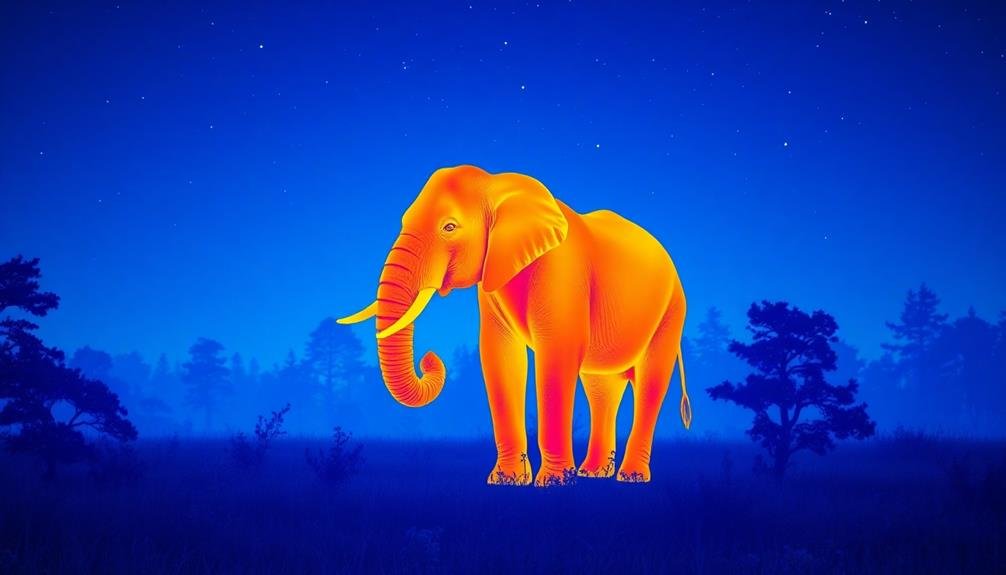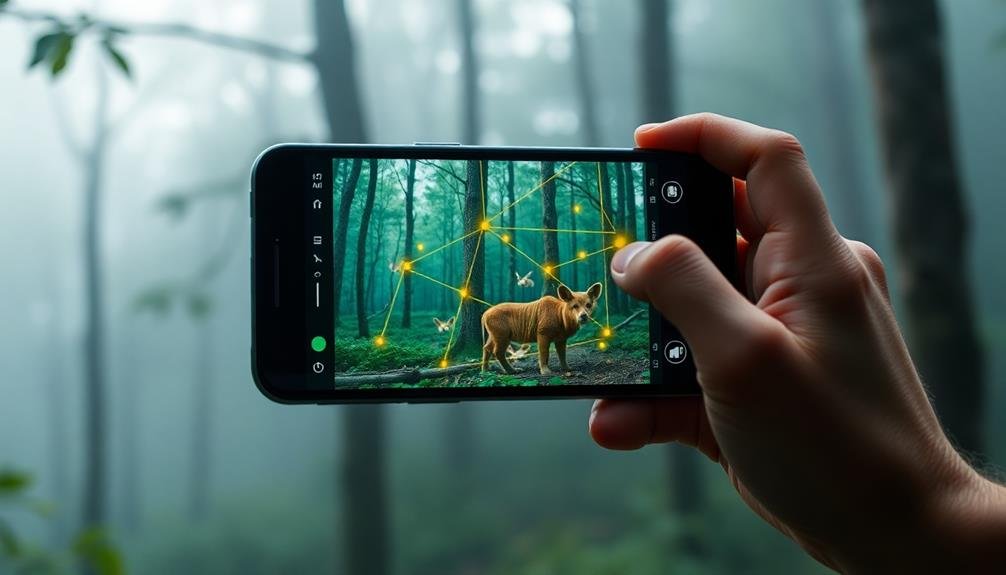To elevate your wildlife conservation photography, embrace these five tech tips: First, invest in a high-quality drone with a 4K camera and obstacle avoidance. Second, master remote sensing techniques like GIS and LiDAR for thorough habitat analysis. Third, utilize thermal imaging cameras to capture elusive nocturnal species. Fourth, implement AI-powered image analysis to efficiently process and categorize your shots. Finally, leverage GPS tracking systems to predict animal movements and optimize your shooting locations. By integrating these cutting-edge technologies, you'll not only capture stunning images but also contribute valuable data to conservation efforts. Discover how these tools can transform your approach to wildlife photography.
Choose the Right Drone

When selecting a drone for wildlife photography, consider both the camera quality and the drone's flight capabilities.
Look for a drone with a high-resolution camera, preferably 4K or higher, and a good image stabilization system. This will guarantee sharp, clear images even when the drone is in motion.
Opt for a drone with a long battery life and extended flight range. You'll want to maximize your time in the air and cover larger areas without frequent landings.
Choose a model with obstacle avoidance technology to prevent crashes in dense environments.
Noise level is vital when photographing wildlife. Select a drone that operates quietly to minimize disturbance to animals. Some models offer "quiet mode" features specifically designed for this purpose.
Consider the drone's portability, especially if you'll be trekking through remote areas. Foldable drones are easier to transport and set up quickly.
Lastly, verify the drone you choose complies with local regulations and has geofencing capabilities to prevent flying in restricted areas. This will help you avoid legal issues and protect sensitive wildlife habitats.
Master Remote Sensing Techniques

Remote sensing techniques can take your wildlife photography to new heights. By utilizing satellite imagery, aerial photography, and other advanced technologies, you'll gain access to valuable data about animal habitats and movements.
Start by familiarizing yourself with Geographic Information Systems (GIS) software, which allows you to analyze and visualize spatial data. Learn to interpret satellite imagery to identify potential wildlife hotspots and track environmental changes over time.
Invest in thermal imaging cameras to capture nocturnal animals or those hidden in dense vegetation. These devices detect heat signatures, enabling you to locate and photograph elusive creatures.
Consider using camera traps equipped with motion sensors to capture images of shy or rare species. Place these devices strategically in known wildlife corridors or feeding areas.
Master the art of LiDAR (Light Detection and Ranging) technology, which creates detailed 3D maps of landscapes. This tool helps you understand terrain features and plan your photography expeditions more effectively.
Don't forget to explore hyperspectral imaging, which can reveal information about vegetation health and animal camouflage. By combining these remote sensing techniques, you'll enhance your ability to locate, track, and photograph wildlife in their natural habitats.
Utilize Thermal Imaging Cameras

Thermal imaging cameras are game-changers for wildlife photographers. These devices detect heat signatures, allowing you to locate and observe animals that might otherwise be hidden from view. You'll be able to spot nocturnal creatures or those concealed in dense vegetation, giving you unprecedented access to previously challenging subjects.
When using thermal cameras, remember that they work best in cooler environments where there's a greater temperature difference between animals and their surroundings. You'll need to adjust your shooting techniques, as thermal images lack the detail of traditional photographs. Focus on capturing unique behaviors and interactions that wouldn't be visible with standard equipment.
To make the most of thermal imaging, combine it with your regular camera setup. Use the thermal device to locate subjects, then switch to your primary camera for high-quality shots. This approach is particularly effective for tracking elusive species or documenting nocturnal activities.
Remember to respect wildlife and maintain a safe distance, as thermal cameras can sometimes make you feel closer to animals than you actually are. With practice, you'll develop a new perspective on wildlife photography and conservation efforts.
Implement AI-Powered Image Analysis

Artificial intelligence is revolutionizing wildlife photography through advanced image analysis. You can now leverage AI-powered tools to enhance your wildlife conservation efforts and streamline your workflow.
These systems can quickly scan through thousands of images, identifying and categorizing different species, behaviors, and environmental conditions.
AI algorithms can help you detect subtle patterns and changes in animal populations over time, which might be difficult for the human eye to notice.
You'll be able to track migration patterns, monitor endangered species, and assess habitat health with greater accuracy.
Some AI tools can even estimate animal ages and genders, providing valuable demographic data for conservation research.
Leverage GPS Tracking Systems
GPS tracking systems have become indispensable tools for wildlife photographers. They allow you to pinpoint animal locations, track migration patterns, and revisit specific shooting spots. By integrating GPS data with your camera, you'll automatically geotag your images, making it easier to organize and reference your work later.
To make the most of GPS tracking in wildlife photography:
- Research and invest in a reliable GPS device compatible with your camera system.
- Learn to interpret GPS data to predict animal movements and behaviors.
- Use GPS coordinates to plan your shoots and optimize your time in the field.
- Share GPS information responsibly to protect sensitive habitats and species.
When choosing a GPS system, consider battery life, durability, and accuracy. Look for models designed for outdoor use that can withstand harsh conditions. Some cameras have built-in GPS capabilities, but external devices often offer more advanced features.
Remember to respect wildlife and their habitats when using GPS technology. Don't disclose sensitive locations publicly, and always prioritize the animals' well-being over getting the perfect shot.
Frequently Asked Questions
How Can I Protect My Equipment From Extreme Weather Conditions?
To protect your equipment from extreme weather, you'll want to use weatherproof cases, silica gel packets, and rain covers. Don't forget to seal your gear in waterproof bags and keep it insulated from temperature extremes when not in use.
What Are the Legal Considerations for Using Technology in Wildlife Photography?
You'll need to contemplate permits, protected species laws, and drone regulations. Don't disturb wildlife or their habitats. Respect privacy laws and property rights. Always check local regulations before using technology for wildlife photography.
How Do I Maintain Battery Life in Remote Locations?
You'll want to pack extra batteries and portable chargers. Use power-saving modes on your devices, turn off unnecessary features, and consider solar chargers. Don't forget to fully charge everything before heading out to remote locations.
Are There Ethical Guidelines for Using Technology Around Wild Animals?
You should follow ethical guidelines when using technology around wildlife. Don't disturb animals or their habitats. Keep your distance, use silent modes, and avoid artificial lighting. Always prioritize the animals' well-being over getting the perfect shot.
What Software Is Best for Organizing and Cataloging Large Volumes of Wildlife Photos?
You'll find Lightroom is excellent for organizing wildlife photos. It's user-friendly and offers powerful tagging and sorting features. For larger collections, consider specialized digital asset management software like Photo Mechanic or Capture One Pro.
In Summary
You've now got the tools to revolutionize your wildlife conservation photography. By embracing drones, remote sensing, thermal imaging, AI analysis, and GPS tracking, you'll capture stunning images while aiding conservation efforts. Remember, technology's just a means to an end. It's your passion and creativity that'll truly make a difference. So get out there, experiment with these tech tips, and let your photography tell powerful stories that inspire action and protect our planet's precious wildlife.

As educators and advocates for responsible drone use, we’re committed to sharing our knowledge and expertise with aspiring aerial photographers.




Leave a Reply